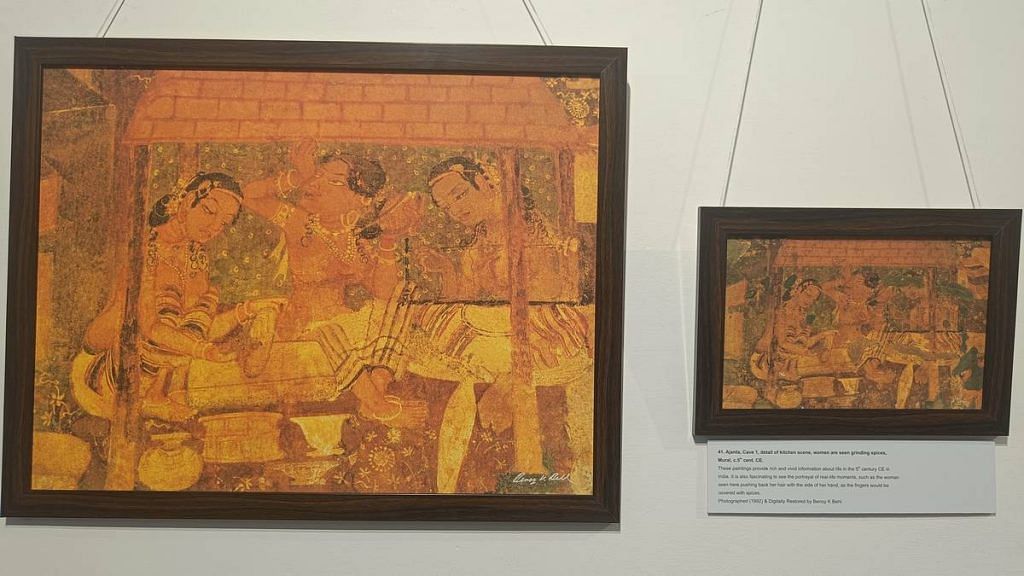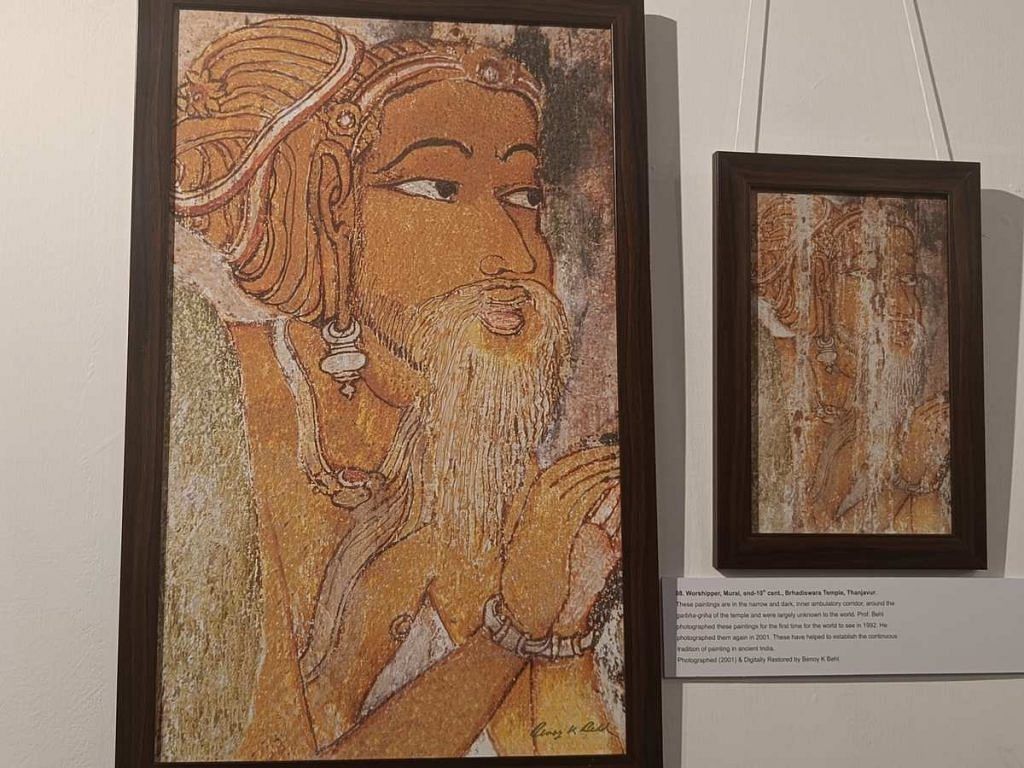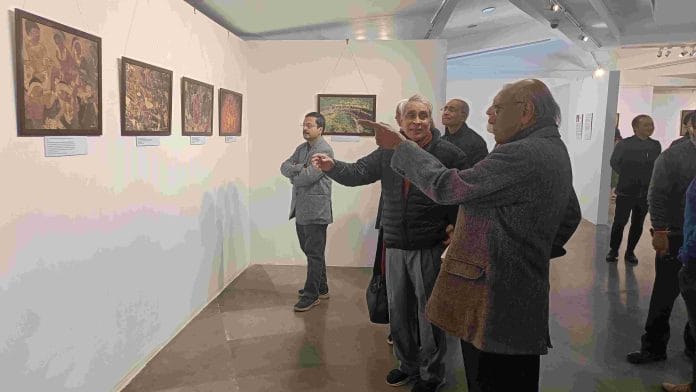New Delhi: For thousands of years, the darkness of the Ajanta Caves shrouded the world’s oldest Buddhist paintings and the glimpses they provided of life in the 5th century CE. That’s until around 1992, when art historian and photographer Professor Benoy Behl captured them using low-light photography. Now, over 30 years later, he has unveiled these ancient treasures, and more, in all their digitally restored glory.
On a misty January morning, the bitter cold did little to deter art lovers and admirers of Behl’s work from filling the art gallery in the Kamaladevi Complex of Delhi’s India International Centre (IIC). Among them were his old friends, former foreign secretary Shyam Saran and prominent technocrat Professor Kiran Karnik. “In a fog-bound morning, the visibility is low. But the visibility of the paintings that you have seen here is tremendous,” said Karnik with a big smile on his face.
Mural from Ajanta Caves to Karnataka’s Badami Caves and Tamil Nadu’s 10th-century Brihadisvara Temple, Behl’s exhibition, aptly titled ‘Lost Ancient Art Revealed’, showcased 30 years of photography and digital restoration for the first time. The event also marked the launch of the new edition of his acclaimed book, The Ajanta Caves.

Complete with detailed descriptions, the photographs were a granular exploration of the corners of ancient sites normally hidden from view, making for an immersive experience. Visitors, visibly enthralled, reached for their smartphones to capture the vivid colours and details as they went from frame to frame.
“When we talk about Indian art and culture, the focus is on sculpture and architecture but not much on painting because most of it has become perishable with time,” said Saran, who first met Behl in the 1990s. He added that Behl’s work had provided a major fillip to “the great tradition of painting in Indian art, going back to hundreds of years”.
Also Read: Delhi-NCR families just got a new activity to do on weekends—strawberry picking in Chhatarpur
Buddhism & a slice of life
Many of the paintings of the Ajanta Caves are based on the Buddhist Jataka tales, which explore Buddha’s past lives as various beings, both animal and human. Some of these depictions, though, are relatable even today, millennia after they were created.
In one painting, for example, women are shown grinding spices. “It is fascinating to see the portrayal of real-life moments, such as the woman seen here pushing her hair with the side of her hand, as the fingers would be covered with spices,” reads the description.

Another mural from the Chola-era Brihadisvara Temple depicts a worshipper, adorned with earrings and sporting a flowing beard, with his hands clasped in earnest prayer.
As Behl explained the meaning of each painting during a walkthrough, Saran asked why they had deteriorated. “They deteriorated with time and were not maintained properly,” Behl replied.
Saran also pointed out that cave paintings extend across a broader geographic range, citing examples in Afghanistan, Chinese-Central Asia, Kazakhstan, Uzbekistan, and Tajikistan. “It is worth looking at the connections which exist between the art we have here and the larger spread of this kind of art,” he said. To this, Behl had a somewhat cryptic response: “The Ajanta Caves have a sense of caring and giving. It would be a cultural weapon in diplomatic terms.”
According to historian William Dalrymple, the Ajanta murals relay Buddhist stories in images of supreme elegance and grace. “Unlike the flatter art of much later Indian miniature painting, here the artists used perspective and foreshortening to produce paintings of courtly life and ascetic renunciation, hunts, battles and liaisons that rank as some of the greatest masterpieces of art produced by mankind in any century,” Dalrymple wrote in the foreword of Behl’s book The Ajanta Caves: Ancient Buddhist Paintings of India.
In exploring the rich tapestry of Indian art, it is essential to consider the influence of various styles, including Thanjavur paintings, which have evolved over centuries and often depict themes similar to those found in the Ajanta murals.

Karnik emphasised that Behl’s work was an important contribution to showcasing India’s heritage. “He has done a fantastic restoration. This exhibition is critical in terms of showing the heritage, preserving it, and documenting it,” said Karnik during the inauguration of the exhibition.
Erica Malhotra, a visitor who first encountered these paintings during a trip to Ajanta in 1970, expressed delight at seeing them again through
Behl’s lens. “This is like revisiting the murals of Ajanta. That was a fascinating time. It is really great to see them restored, more or less in the way that they used to be,” she said.
Also Read: Is Qatar’s influence testing India’s diplomatic power? Delhi event decodes Doha’s power games
Conquered the darkness
For Behl, capturing the hidden beauty of ancient cave paintings was more a spiritual journey than a technical achievement, he said.
“The many weeks I spent, many years ago, documenting these glorious paintings in the Ajanta Caves, transformed me. They conveyed the meaning of life,” he added. “It was a long labour of love.”
Behl recalled that a conversation with officials of the Ministry of Culture in 1990 sparked his interest in the Ajanta Cave paintings. “These paintings had never been seen clearly. And at that time, I felt that my technology could be used for the good of the world,” said Behl, whose low-light photography is noted worldwide.
Using strong lights is prohibited in the pitch-dark Ajanta Caves, but Behl was confident he could still capture quality images. “The photos were taken in such a condition where you cannot even see your hand in the dark,” he recalled.
However, while the images came out well, there was another challenge. Time and neglect had taken their toll on the paintings, with moisture and graffiti leaving their mark. To counter this, Behl embarked on the laborious process of digital restoration. “Restoration work has to be done very carefully just to make the paintings more clear. You have to lose yourself to the art for this. It is a difficult and careful task,” he said.
In his 47 years of photography, Behl has taken over 53,000 photographs of Asian monuments and art heritage. He has also made 147 documentary films on art history.
In 2020, an acclaimed photograph of an Ajanta painting taken by Behl was archived in the vaulted depths of the Arctic World Archive in Norway, a sanctuary for preserving cultural heritage and “world memory”. In 2021, his digitally restored image of the earliest surviving Hindu painting at the Badami Caves was also preserved in this archive.
Behl doesn’t shy away from expressing pride in his achievements in low-light photography. “Its quality is unsurpassed,” he said. “Even photography done with light does not have the quality that people have noticed in my low-light photography.”
(Edited by Asavari Singh)






